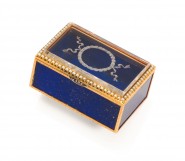Lot #31 - Ian Fairweather
-
Auction House:Deutscher and Hackett
-
Sale Name:Important Australian + International Fine Art
-
Sale Date:01 Dec 2022 ~ 7pm (AEDT)
-
Lot #:31
-
Lot Description:Ian Fairweather
(1891 - 1974)
Peking Walls, 1948
gouache and pencil on paper
41.5 x 46.0 cm (sheet)
signed indistinctly lower left: Fairweather -
Provenance:The Redfern Gallery Ltd., London (label attached verso); Mrs Ruth Keating, London, acquired from the above in 1948; Thence by descent; Private collection, USA
-
Exhibited:Ian Fairweather, Redfern Gallery, London, 28 October – 20 November 1948, cat. 40
-
Notes:No Australian twentieth century artist understood Asia better than Ian Fairweather. It began in improbable circumstances as a prisoner of war. He enlisted in the British Army in June 1914 and, within two months of arriving in France, was captured by the Germans. He read works by E. F. Fenollosa and Lafcadio Hearn (two distinguished scholars on Japan), illustrated prisoner-of-war magazines and attempted unsuccessful escapes. Back in London he studied at the Slade School of Fine (1920 – 24) while attending evening classes in Japanese and Chinese at the School of Oriental and African Studies. By 1929, he was in Shanghai and remained in China until 1932. His peripatetic nature, restless curiosity and affection for China saw him return there in 1935 where he was 'completely at home with (his) fellows.'1 Travel to other places followed, from South East Asia to Calcutta – and regardless of location, Chinese subjects continued. It was a necessary and essential part of his personality. Indeed, the idea for Monastery, 1961 (National Gallery of Australia) remained in his memory for more than two decades before it was realised.2 In Peking Walls, 1948 we find Fairweather's synchronised approach to painting, one which would evolve into larger, grand paintings during the sixties. Both however have the same underpinning: Chinese thought and experience, and his unmistakable, idiosyncratic technical fluency. Drawing with paint is used extensively across mediums – from paper to card and wooden panels, calligraphic-like gestures over layered surfaces result in final irregular painting, a finished work. Fairweather's observation is always one of creative approximation, forever avoiding the dullness of literalism.3 There is no suggestion of a clichéd, exotic Western unfamiliarity in Peking Walls where stereotypes might suffice. Fairweather was too immersed in Chinese culture, philosophy, language and art to fall into some kind of Asian Grand Tour romanticism. While certain subtle inflections suggest a nod to Matisse and the French Nabis – for example, painted lineal suggestions and blotchy shapes of colour – there are specific Chinese characteristics in works such as these as well. There are also similarities with Peking Tea Room, 1936 (Art Gallery New South Wales) ? it clearly complements Peking Walls but is one of many later iterations of subjects that remained a perpetual echo. What might appear as Fairweather's clumsiness of execution as an individual stylistic trait, is actually an aesthetic virtue shaped by his understanding of Chinese painting. As Pierre Ryckmans notes in his discussion of spiritual deficiency and finish in Chinese painting, '...technical virtuosity and seductiveness in a painting are considered vulgar, as they precisely suggest the slick fluency of a professional answering a client's commission and betray a lack of inner compulsion on the part of the artist.'4 Peking Walls is the clear, continuing and evolving expression born from his visits to China in the 30s. Fairweather paints vastness and intimacy, figures in the foreground to a mid-ground market canopy. The painted lineal sweeps in halftones are interspersed with his familiar use of a rich ultramarine or, in Fairweather's specific case, Reckitt's blue.5 1. Abbott-Smith, N., Ian Fairweather: profile of a painter; University of Queensland Press, Brisbane, 1978, p. 27; 2. Capon, J., 'The China Years' cited in Bail, M., et al., Fairweather, Queensland Art Gallery, Brisbane, 1994, p.63; 3. For a specific analysis of Fairweather's approach see, Fisher, T., The Drawings of Ian Fairweather, National Gallery of Australia, Canberra, 1997, pp. 4 – 7; 4. Ryckmans, P., 'The Amateur Artist', in Bail, op. cit., pp. 15 – 23; 5. Roberts, C. & Thompson, J., (eds.), Ian Fairweather: A Life in Letters, Text Publishing, Melbourne, 2019. This publication provides a rich, first-person account in letters from the artist, many of which are about China. DOUG HALL AM
-
Estimate:A$70,000 - 90,000
-
Realised Price:
-
Category:Art
This Sale has been held and this item is no longer available. Details are provided for information purposes only.










